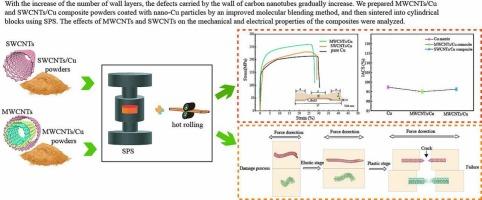Enhancement of mechanical and electrical properties of copper matrix composites by different types of carbon nanotubes
IF 4.8
2区 材料科学
Q1 MATERIALS SCIENCE, CHARACTERIZATION & TESTING
引用次数: 0
Abstract
Copper-based composites with carbon nanotubes (CNTs) as the reinforcing phase possess excellent comprehensive mechanical and electrical properties and have received widespread attention in the electronics industry in recent years. However, a handful of studies concerns CNTs reinforced copper matrix composites with different wall layers. In this study, multi-walled carbon nanotubes (MWCNTs) and single-walled carbon nanotubes (SWCNTs) were selected. An improved molecular-level blending method was exploited to produce copper matrix composites reinforced by MWCNTs and SWCNTs in our study. The characterization results showed that the copper coated MWCNTs and SWCNTs were evenly distributed in the copper matrix and ensured the connection structure tightly between CNTs as heterogeneous strengthening factors and the copper matrix. Meanwhile, in the mechanical property test, the MWCNTs/Cu composite material had the highest tensile strength (262.5 MPa), which was 23.6 % higher than pure copper and 12.6 % higher than the SWCNTs/Cu composite materials. In addition, in the electrical performance test, MWCNTs/Cu and SWCNTs/Cu composites all possessed excellent electrical conductivity, 95 % IACS and 96 % IACS, respectively. The research work in this paper can be extended to the development of ultra-light copper and copper alloy electronic devices and provide a reference for future research on CNTs augmented metal matrix composites.

用不同类型的碳纳米管提高铜基复合材料的机械和电气性能
以碳纳米管(CNTs)为增强相的铜基复合材料具有优异的综合机械和电气性能,近年来在电子行业受到广泛关注。然而,关于不同壁层的碳纳米管增强铜基复合材料的研究屈指可数。本研究选择了多壁碳纳米管(MWCNT)和单壁碳纳米管(SWCNT)。我们的研究采用了一种改进的分子级混合方法来生产由 MWCNTs 和 SWCNTs 增强的铜基复合材料。表征结果表明,镀铜的 MWCNTs 和 SWCNTs 均匀分布在铜基体中,确保了作为异质增强因子的 CNTs 与铜基体之间的紧密连接结构。同时,在力学性能测试中,MWCNTs/Cu 复合材料的抗拉强度最高(262.5 MPa),比纯铜高 23.6%,比 SWCNTs/Cu 复合材料高 12.6%。此外,在电性能测试中,MWCNTs/Cu 和 SWCNTs/Cu 复合材料都具有优异的导电性,分别达到 95 % IACS 和 96 % IACS。本文的研究工作可扩展到超轻型铜和铜合金电子器件的开发,并为未来研究 CNTs 增强金属基复合材料提供参考。
本文章由计算机程序翻译,如有差异,请以英文原文为准。
求助全文
约1分钟内获得全文
求助全文
来源期刊

Materials Characterization
工程技术-材料科学:表征与测试
CiteScore
7.60
自引率
8.50%
发文量
746
审稿时长
36 days
期刊介绍:
Materials Characterization features original articles and state-of-the-art reviews on theoretical and practical aspects of the structure and behaviour of materials.
The Journal focuses on all characterization techniques, including all forms of microscopy (light, electron, acoustic, etc.,) and analysis (especially microanalysis and surface analytical techniques). Developments in both this wide range of techniques and their application to the quantification of the microstructure of materials are essential facets of the Journal.
The Journal provides the Materials Scientist/Engineer with up-to-date information on many types of materials with an underlying theme of explaining the behavior of materials using novel approaches. Materials covered by the journal include:
Metals & Alloys
Ceramics
Nanomaterials
Biomedical materials
Optical materials
Composites
Natural Materials.
 求助内容:
求助内容: 应助结果提醒方式:
应助结果提醒方式:


